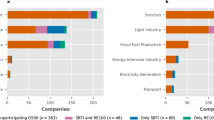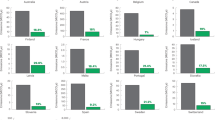Abstract
Corporate climate action is increasingly considered important in driving the transition towards a low-carbon economy1. For this, it is critical to ensure translation of global goals to greenhouse-gas (GHG) emissions reduction targets at company level2,3. At the moment, however, there is a lack of clear methods to derive consistent corporate target setting that keeps cumulative corporate GHG emissions within a specific carbon budget (for example, 550–1,300 GtCO2 between 2011 and 2050 for the 2 °C target4). Here we propose a method for corporate emissions target setting that derives carbon intensity pathways for companies based on sectoral pathways from existing mitigation scenarios: the Sectoral Decarbonization Approach (SDA). These company targets take activity growth and initial performance into account. Next to target setting on company level, the SDA can be used by companies, policymakers, investors or other stakeholders as a benchmark for tracking corporate climate performance and actions, providing a mechanism for corporate accountability.
This is a preview of subscription content, access via your institution
Access options
Subscribe to this journal
Receive 12 print issues and online access
$209.00 per year
only $17.42 per issue
Buy this article
- Purchase on Springer Link
- Instant access to full article PDF
Prices may be subject to local taxes which are calculated during checkout

Similar content being viewed by others
References
Persson, Å & Rockström, J. Business leaders. Nature Clim. Change 1, 426–427 (2011).
Sullivan, R. & Gouldson, A. Ten years of corporate action on climate change: What do we have to show for it? Energy Policy 60, 733–740 (2013).
Gouldson, A. & Sullivan, R. Long-term corporate climate change targets: What could they deliver? Environ. Sci. Policy 27, 1–10 (2013).
IPCC Climate Change 2014: Mitigation of Climate Change (eds Edenhofer, O. et al.) (Cambridge Univ. Press, 2014).
Blok, K., Höhne, N., van der Leun, K. & Harrison, N. Bridging the greenhouse-gas emissions gap. Nature Clim. Change 2, 1–4 (2012).
Climate Commitments of Subnational Actors and Business: A Quantitative Assessment of Their Emission Reduction Impact (United Nations Environment Programme (UNEP), 2015); http://apps.unep.org/publications/pmtdocuments/-Climate_Commitments_of_Subnational_Actors_and_Business-2015CCSA_2015.pdf
Höhne, N., den Elzen, M. & Escalante, D. Regional GHG reduction targets based on effort sharing: A comparison of studies. Clim. Policy 14, 122–147 (2014).
Akimoto, K. et al. Global emission reductions through a sectoral intensity target scheme. Clim. Policy 8, S46–S59 (2008).
Phylipsen, G. J. M., Bode, J. W. & Blok, K. A triptych sectoral approach to burden differentiation; GHG emissions in the European bubble. Energy Policy 26, 929–943 (2000).
Trancik, J. E., Chang, M. T., Karapataki, C. & Stokes, L. C. Effectiveness of a segmental approach to climate policy. Environ. Sci. Policy 48, 27–35 (2014).
Pauliuk, S., Dhaniati, N. M. A. & Müller, D. B. Reconciling sectoral abatement strategies with global climate targets: The case of the chinese passenger vehicle fleet. Environ. Sci. Technol. 46, 140–147 (2012).
Girod, B., van Vuuren, D. P. & Hertwich, E. G. Corrigendum: Global climate targets and future consumption level: An evaluation of the required GHG intensity. Environ. Res. Lett. 8, 029501 (2013).
The 3% Solution: Driving Profits Through Carbon Reduction (CDP & WWF, 2013); http://assets.worldwildlife.org/publications/575/files/original/The_3_Percent_Solution_-_June_10.pdf?1371151781
Ford’s Science-Based CO2 Targets (Ford, 2012); http://corporate.ford.com/microsites/sustainability-report-2013-14/environment-climate-strategy-targets.html
Stewart, E. & Deodhar, A. A Corporate Finance Approach to Climate-stabilizing Targets (”C-FACT”) 1–11 (Autodesk, 2009); http://static.autodesk.net/dc/content/dam/autodesk/www/sustainability/docs/pdf/greenhouse_gas_white_paper000.pdf
Randers, J. Greenhouse gas emissions per unit of value added (‘GEVA’)—A corporate guide to voluntary climate action. Energy Policy 48, 46–55 (2012).
Energy Technology Perspectives 2014 (IEA, 2014); http://www.iea.org/etp/etp2014
Van Vuuren, D. P. et al. RCP2.6: Exploring the possibility to keep global mean temperature increase below 2 °C. Climatic Change 109, 95–116 (2011).
A Corporate Accounting and Reporting Standard (Greenhouse Gas Protocol, 2004); http://www.ghgprotocol.org/files/ghgp/public/ghg-protocol-revised.pdf
Unruh, G. C. Understanding carbon lock-in. Energy Policy 28, 817–830 (2000).
Acknowledgements
The target-setting approach proposed in this article is developed as a part of the Science Based Targets initiative; a collaborative effort of CDP (formerly known as the Carbon Disclosure Project), the United Nations Global Compact, the World Resources Institute (WRI), and WWF. The authors would like to thank the International Energy Agency for providing the data of their 2DS scenario.
Author information
Authors and Affiliations
Contributions
O.K. acquired, analysed and interpreted the data, and drafted the manuscript. G.L. and K.B. designed and led the study and contributed to the analysis and interpretation of the data. W.C.-G., N.H. and D.P.v.V. critically reviewed the manuscript. P.F., N.A. and A.C.P. contributed to developing the methodological approach and aided in improving the mathematical formulae.
Corresponding author
Ethics declarations
Competing interests
The authors declare no competing financial interests.
Supplementary information
Rights and permissions
About this article
Cite this article
Krabbe, O., Linthorst, G., Blok, K. et al. Aligning corporate greenhouse-gas emissions targets with climate goals. Nature Clim Change 5, 1057–1060 (2015). https://doi.org/10.1038/nclimate2770
Received:
Accepted:
Published:
Issue Date:
DOI: https://doi.org/10.1038/nclimate2770
This article is cited by
-
Assessments of the environmental performance of global companies need to account for company size
Communications Earth & Environment (2024)
-
Incorporating the choice of centralized vs. decentralized resource allocation into sustainability frameworks
Journal of Organization Design (2024)
-
Increased transparency is needed for corporate science-based targets to be effective
Nature Climate Change (2023)
-
Evaluating fossil fuel companies’ alignment with 1.5 °C climate pathways
Nature Climate Change (2023)
-
The alignment of companies' sustainability behavior and emissions with global climate targets
Nature Communications (2023)



